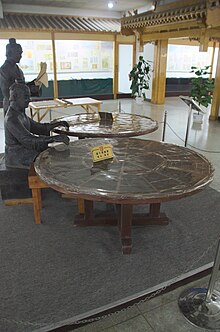Bi Sheng
| Bi Sheng | |||||||||||||||||||
|---|---|---|---|---|---|---|---|---|---|---|---|---|---|---|---|---|---|---|---|
| Traditional Chinese | 畢昇 | ||||||||||||||||||
| Simplified Chinese | 毕昇 | ||||||||||||||||||
| |||||||||||||||||||

Bi Sheng (972–1051) was a Chinese artisan and engineer during the Song dynasty (960–1279), who invented the world's first movable type. Bi's system used fired clay tiles, one for each Chinese character, and was invented between 1039 and 1048. Printing was one of the Four Great Inventions. Because Bi was a commoner, not an educated person, little is known about his life besides this invention.[1]
Movable type printing
[edit]Bi Sheng's invention was only recorded in the Dream Pool Essays by Chinese scholar-official and polymath Shen Kuo (1031–1095). The book provides a detailed description of the technical details of Bi Sheng's invention of movable type printing:
During the reign of Chingli 慶曆 (Qìnglì), 1041–1048, Bi Sheng, a man of unofficial position, made movable type. His method was as follows: He prepared an iron plate. Then he took sticky clay and cut in its characters as thin as the edge of a coin. Each character formed, as it were, a single type. He baked them in the fire to make them hard. He had covered the plate with a mixture of pine resin, wax, and paper ashes. When he wished to print, he took an iron frame and set it on the iron plate. In this, he placed the types, set close together. When the frame was full, the whole made one solid block of type. He then placed it near the fire to warm it. When the paste [at the back] was slightly melted, he took a smooth board and pressed it over the surface, so that the block of type became as even as a whetstone.
For each character, there were several types, and for certain common characters, there were twenty or more types each, in order to be prepared for the repetition of characters on the same page. When the characters were not in use he had them arranged with paper labels, one label for each rhyme-group, and kept them in wooden cases.[2]
During the next several centuries, movable type was seldom mentioned or described. Wooden movable-type printing became widespread in the Qing dynasty (1644–1912), but did not replace block printing, probably because of the expense of creating a font of so many pieces or the low cost of a copyist.[1] The government official Wang Zhen (fl. 1290–1333) improved Bi Sheng's clay types by innovation through the wood, as his process increased the speed of typesetting as well.[3] By 1490, bronze movable type was developed by the wealthy printer Hua Sui (1439–1513).
Legacy
[edit]Bisheng Subdistrict (畢昇社區) in Wenquan, Huanggang, Hubei is named for Bi Sheng. The Bi Sheng crater located in the LAC-7 quadrant near the northern pole on the far side of the Moon was named after Bi Sheng by the IAU in August 2010.[4]
He also appears in a commemorative stamp by the Liberian post office due to his invention of movable printing.
See also
[edit]References
[edit]- ^ a b Wilkinson (2022), p. 1031.
- ^ Needham & Tsien (1985), pp. 201–202.
- ^ Needham & Tsien (1985), pp. 203–208.
- ^ Blue, Jennifer (25 July 2007). "Gazetteer of Planetary Nomenclature". USGS. Retrieved 5 August 2007.
Sources
[edit]- Needham, Joseph; Tsien, Tsuen-hsuin, eds. (1985). Chemistry and Chemical Technology: Paper and Printing. Science and Civilisation in China. Vol. V:1. Cambridge University Press. ISBN 978-0-521-08690-5.
- Wilkinson, Endymion (2022) [1973]. Chinese History: A New Manual. Cambridge, MA: Harvard University Press. p. 1031. ISBN 978-0-674-26018-4.
Further reading
[edit]- Shelton A. Gunaratne (2001). Paper, printing and the printing press: A horizontally integrative macrohistory analysis. International Communication Gazette, 63 (6) 459-470.
